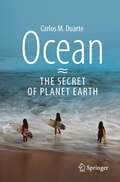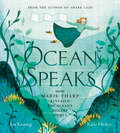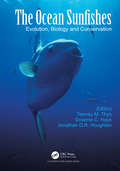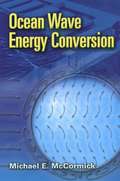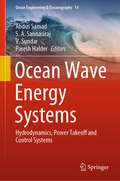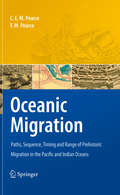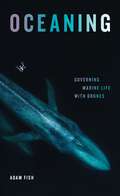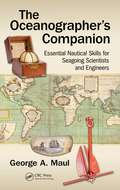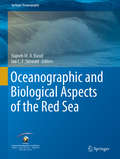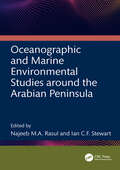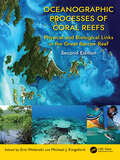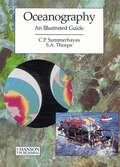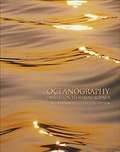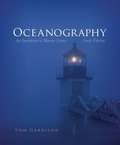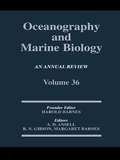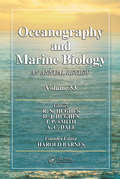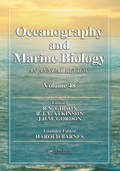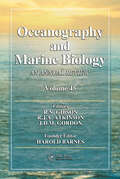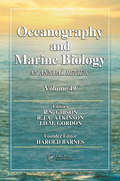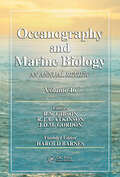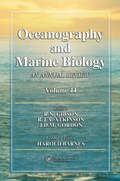- Table View
- List View
Ocean Pollution: Effects on Living Resources and Humans
by Carl J. SindermannOcean Pollution provides a unique look at the effects of estuarine and coastal pollution on resource species. One of the primary objectives of the book is to provide an accurate assessment of the state of the inshore marine environment and its inhabitants. Coastal habitat degradation is discussed, and principal findings from modeling and other rese
Ocean - The Secret of Planet Earth
by Carlos M. DuarteThe ocean characterises planet Earth and differentiates it from the more than 5000 known planets. It is also the habitat where life emerged as a singularity in the universe. However, we know less about the oceans than we do about some remote planets such as Mars.This book provides basic facts for understanding the oceans, their properties and their importance to mankind through the ages. The long relationship between the ocean and humanity, which permeates all areas of our culture, is at a crossroads where human activity is profoundly affecting its functioning and the integrity of marine ecosystems. However, the intelligent and rational use of the ocean holds, in large part, the key to providing the resources needed to sustain our quality of life in the future. Unlocking, through scientific research, the secrets that the ocean still holds is an essential challenge for humanity. This book informs the reader about all these aspects of the ocean through a text that combines scientific rigour with personal reflections based on the author's own experiences, dedicated to exploring and learning more about the ocean.
Ocean Speaks: How Marie Tharp Revealed the Ocean's Biggest Secret
by Jess KeatingMeet Marie Tharp (1920-2006), the first person to map the Earth's underwater mountain ridge, in this inspiring picture book biography from the author of Shark Lady.From a young age, Marie Tharp loved watching the world. She loved solving problems. And she loved pushing the limits of what girls and women were expected to do and be. In the mid-twentieth century, women were not welcome in the sciences, but Marie was tenacious. She got a job at a laboratory in New York. But then she faced another barrior: women were not allowed on the research ships (they were considered bad luck on boats). So instead, Marie stayed back and dove deep into the data her colleagues recorded. She mapped point after point and slowly revealed a deep rift valley in the ocean floor. At first the scientific community refused to believe her, but her evidence was irrefutable. She proved to the world that her research was correct. The mid-ocean ridge that Marie discovered is the single largest geographic feature on the planet, and she mapped it all from her small, cramped office.
The Ocean Sunfishes: Evolution, Biology and Conservation
by Tierney M. Thys; Graeme C. Hays; Jonathan D.R. HoughtonThe Ocean Sunfishes: Evolution, Biology and Conservation is the first book to gather into one comprehensive volume our fundamental knowledge of the world-record holding, charismatic ocean behemoths in the family Molidae. From evolution and phylogeny to biotoxins, biomechanics, parasites, husbandry and popular culture, it outlines recent and future research from leading sunfish experts worldwide This synthesis includes diet, foraging behavior, migration and fisheries bycatch and overhauls long-standing and outdated perceptions. This book provides the essential go-to resource for both lay and academic audiences alike and anyone interested in exploring one of the ocean’s most elusive and captivating group of fishes.
Ocean Wave Energy Conversion (Dover Civil and Mechanical Engineering)
by Michael E. MccormickThis volume will prove of vital interest to those studying the use of renewable resources. Scientists, engineers, and inventors will find it a valuable review of ocean wave mechanics as well as an introduction to wave energy conversion. It presents physical and mathematical descriptions of the nine generic wave energy conversion techniques, along with their uses and performance characteristics.Author Michael E. McCormick is the Corbin A. McNeill Professor of Naval Engineering at the U.S. Naval Academy. In addition to his timely and significant coverage of possible environmental effects associated with wave energy conversion, he provides a separate treatment of several electro-mechanical energy conversion techniques. Many worked examples throughout the book will be particularly useful to readers with a limited mathematical background. Those interested in research and development will benefit from the extensive bibliography.
Ocean Wave Energy Systems: Hydrodynamics, Power Takeoff and Control Systems (Ocean Engineering & Oceanography #14)
by Abdus Samad V. Sundar S. A. Sannasiraj Paresh HalderThis book offers a timely review of wave energy and its conversion mechanisms. Written having in mind current needs of advanced undergraduates engineering students, it covers the whole process of energy generation, from waves to electricity, in a systematic and comprehensive manner. Upon a general introduction to the field of wave energy, it presents analytical calculation methods for estimating wave energy potential in any given location. Further, it covers power-take off (PTOs), describing their mechanical and electrical aspects in detail, and control systems and algorithms. The book includes chapters written by active researchers with vast experience in their respective filed of specialization. It combines basic aspects with cutting-edge research and methods, and selected case studies. The book offers systematic and practice-oriented knowledge to students, researchers, and professionals in the wave energy sector.Chapters 17 of this book is available open access under a CC BY 4.0 license at link.springer.com
Ocean Wave Mechanics: Applications in Marine Structures (ANE/Athena Books)
by V. SundarThis is a textbook aimed at graduate students and offshore engineering practitioners that covers basic fluid mechanics and the deterministic and statistical descriptions of infinitesimal and finite amplitude water waves. It reviews the theory of wave loading on structures and closes with a chapter on the potential of ocean wave energy and devices for extracting it. Since the 1980s there has been tremendous progress in numerical and physical modelling of coastal and offshore structures in waves. This calls for a clear understanding of the phenomena of wave generation, propagation, deformation and its effects on marine structures. This book will help the reader to understand the many results and descriptions found in journals, reports and research papers. It is self-contained, and encompasses the fundamentals of the subject with sufficient description and illustrations.
Ocean Zoning: Making Marine Management More Effective (Earthscan Oceans Ser.)
by Tundi S. AgardyOur knowledge of the oceans is increasing rapidly, as more powerful tools for exploration and exploitation make it easier to locate valuable resources, such as fish stocks, oil and gas reserves, or sites for wind and hydropower schemes. At the same time competition for space has intensified, affecting marine life and people's livelihoods. Much has been written about marine management using marine protected areas, but MPAs are only a small subset of spatial management tools available. MPAs and MPA networks are better seen as starting points for more comprehensive spatial management, facilitated by ocean zoning. This logical scaling up from discreet piecemeal protected areas to larger and more systematic planning is happening around the world, but few are aware that we are entering a brave new world in ocean management with zoning at its core. This book provides guidance on using ocean zoning to improve marine management. It reviews the benefits of ocean zoning in theory, reviews progress made in zoning around the world through a wide range of case studies, and derives lessons learned to recommend a process by which future zoning can be maximally effective and efficient. Published with MARES, Forest Trends and UNEP
Oceanic Internal Tides: Observations, Analysis and Modeling
by Eugene G. MorozovThis book presents a detailed study of the structure and variability of internal tides and their geographical distribution in the ocean. Based on experimental analysis of oceanic measurements combined with numerical modeling, it offers a comprehensive overview of the internal wave processes around the globe. In particular, it is based on moored buoys observations in many regions in all oceans (Atlantic, Pacific, Indian, Arctic, and Southern) that have been carried out by researchers from different countries for more than 40 years as part of various oceanographic programs, including WOCE and CLIVAR. However, a significant portion of the data was collected by the author, who is a field oceanographer. The data was processed and interpreted on the basis of the latest knowledge of internal wave motion. The properties of internal waves were analyzed in relation to the bottom topography and mean state of the ocean in specific regions. Internal waves play a major role in the formation of seawater stratification and are responsible for the main processes of ocean dynamics, such as energy transfer and mixing. One of the most significant ideas presented in this book is the generation of internal tides over submarine ridges. Energy fluxes from submarine ridges related to tidal internal waves greatly exceed the fluxes from continental slopes. Submarine ridges form an obstacle to the propagation of tidal currents, which can cause the creation of large amplitude internal tides. Energy fluxes from submarine ridges account for approximately one fourth of the total energy dissipation of the barotropic tides. Model simulations and moored measurements have been combined to generate a map of global distribution of internal tide amplitudes. This book is of interest to oceanographers, marine biologists, civil engineers, and scientists working in climate research, fluid mechanics, acoustics, and underwater navigation.
Oceanic Migration
by F. M. Pearce Charles E.M. PearceOceanic Migration studies the prehistoric peopling of the Pacific. It uses science and mathematics to expand the research base of Pacific prehistory and casts new light on this final human expansion. It explores the fundamental roles of oceanography and of global climate change in determining the paths, sequence, timing and range of Spice Island-based maritime migrations ranging across a quarter of the globe. The book is of interest to Pacific prehistorians, oceanographers and American anthropologists concerned with the diffusionist debate. For oceanographers it presents the new idea of the role of the West Pacific Warm Pool and of three of its four major currents in determining the evolution of voyaging in two oceans. For diffusionists it provides new chronological and technological contexts in which the issue of diffusionism needs to be reconsidered. For prehistorians it creates a paradigmatic shift by establishing a new time depth and mechanism for Polynesian exploration, offers a new view of voyaging and exploration strategies and of economic imperatives and adds a new dimension to the debate on Polynesian origins.
Oceaning: Governing Marine Life with Drones (Elements)
by Adam FishDrones are revolutionizing ocean conservation. By flying closer and seeing more, drones enhance intimate contact between ocean scientists and activists and marine life. In the process, new dependencies between nature, technology, and humans emerge, and a paradox becomes apparent: Can we have a wild ocean whose survival is reliant upon technology? In Oceaning, Adam Fish answers this question through eight stories of piloting drones to stop the killing of porpoises, sharks, and seabirds and to check the vitality of whales, seals, turtles, and coral reefs. Drone conservation is not the end of nature. Instead, drone conservation results in an ocean whose flourishing both depends upon and escapes the control of technologies. Faulty technology, oceanic and atmospheric turbulence, political corruption, and the inadequacies of basic science serve to foil governance over nature. Fish contends that what emerges is an ocean/culture—a flourishing ocean that is distinct from but exists alongside humanity.
The Oceanographer's Companion: Essential Nautical Skills for Seagoing Scientists and Engineers
by George MaulScientists and engineers embarking on their first voyage for oceanographic or meteorological research are often unprepared for the experience. Going to sea involves learning a new language – that of the seaman. This is necessary for clear communications, for the safety and well-being of the members of the scientific party and the ship’s crew. The Oceanographer’s Companion is intended to familiarize a student with the basics of navigation, seamanship, marine engineering, communications, safety-of-life-at-sea, shiphandling, knots and splices, first aid, and so much more. The book will have a very practical feel with lots of examples.
Oceanographic and Biological Aspects of the Red Sea (Springer Oceanography)
by Najeeb M.A. Rasul Ian C.F. StewartThis book includes invited contributions presenting the latest research on the oceanography and environment of the Red Sea. In addition to covering topics relevant to research in the region and providing insights into marine science for non-experts, it is also of interest to those involved in the management of coastal zones and encourages further research on the Red Sea
Oceanographic and Marine Environmental Studies around the Arabian Peninsula
by Najeeb M.A. Rasul Ian C.F. StewartOceanographic and Marine Environmental Studies around the Arabian Peninsula presents studies on a range of topics related to the marine environment of the Red Sea and Arabian (Persian) Gulf.This book contains invited and peer-reviewed chapters from diverse researchers active in their respective fields. The chapters offer new data and include a comprehensive lists of references. Some of the main topics included in the book are pollution from heavy metals and petroleum, hydro-environmental characteristics of the seas, conservation of marine ecosystems, risk of climate change on the Red Sea region, and the mangrove environment.With new developments occurring in the coastal regions in recent decades, the book will be not only a helpful resource to researchers but also be a valuable reference for anyone curious about managing the marine and littoral environment of these two unique seas.
Oceanographic Processes of Coral Reefs: Physical and Biological Links in the Great Barrier Reef
by Eric Wolanski Michael J. KingsfordIn the last two decades since publication of the first edition, substantial advancements have been made in the science, the need for transdisciplinary approaches to coral reef protection greater than ever before. This new edition, now in full color throughout with accompanying animations, goes beyond identifying foundational information and current problems to pinpoint science-based solutions for managers, stakeholders and policy makers. Coral reefs are connected by currents that carry plankton and the larvae of many reef-based organisms. Further, they supply food to reefs. Currents also bring pollutants from the land and, together with the atmosphere, affect the surrounding ocean. The chapters in this book provide a much-needed review of the biophysics of reefs with an emphasis on the Great Barrier Reef as an ecosystem. The focus is on interactions between currents, waves, sediment and the dynamics of coastal and reef-based ecosystems. The topographic complexity of reefs redirects mainstream currents, creates tidal eddies, mushroom jets, boundary layers, stagnation zones, and this turbulence is enhanced by the oceanographic chaos in the adjoining Coral Sea. This is the environment in which particles and organisms, of a range of sizes live, from tiny plankton to megafauna. This generates faunal connectivity at scales of meters to thousands of km within the Great Barrier Reef and with the adjoining ocean. Pollution from land-use is increasing and remedial measures are described both on land and on coral cays. The impact of climate change is quantified in case studies about mangroves and corals. Modelling this biophysical complexity is increasing in sophistication, and the authors suggest how the field can advance further.
Oceanography: An Illustrated Guide
by S. A. ThorpeOceans cover over 70% of the planet's surface and are essential to life on earth, yet their deepest mysteries remained unexplored until very recently when 20th century technological advances allowed the vast expansion of our frontiers of knowledge, and worldwide interest in oceanography grew rapidly.Combining the skills of 40 contributors from worl
Oceanography: An Invitation to Marine Science (4th edition)
by Tom GarrisonThis edition provides an interesting, clear, current, and reasonably comprehensive overview of the marine sciences and is designed for college and university students who are curious about Earth's largest feature, but who may have little formal background in science.
Oceanography: An Invitation to Marine Science
by Tom S. GarrisonThe ocean affects all aspects of our lives--Tom Garrison will show you how in this new edition of OCEANOGRAPHY: AN INVITATION TO MARINE SCIENCE. Garrison takes you on a vivid exploration of the ocean--from submarine canyons to zooplankton, global warming, the growing plastics problem, and our changing coastlines--and explains oceanography's most important concepts. Garrison's friendly approach helps you understand the complexities involved in how we study and use the ocean. You'll explore topics like Hurricane Katrina; the devastating December 2004 earthquake in the Indian Ocean and the resulting tsunami; the Moon and its connection to the ocean; the power of the ocean to influence weather; and uses and abuses of the ocean. Gain an understanding of the wonders of the sea and the scientific questions that surround it with this fascinating text!
Oceanography And Marine Biology: Volume 36 (Oceanography And Marine Biology Ser. #Vol. 36)
by Harold Barnes A. D. Ansell R. N. Gibson Margaret BarnesOceanography and Marine Biology: an Annual Review considers basic areas of marine research, returning to them when appropriate in future volumes, and deals with subjects of special and topical importance in the field of marine biology. The thirty-sixth volume follows closely the objectives and style of the earlier well recieved volumes, conti
Oceanography and Marine Biology: An annual review. Volume 53 (ISSN)
by A. C. Dale I. P. Smith R. N. Hughes D. J. HughesThe book examines basic areas of marine research, subjects of special and topical importance; and new areas as they arise. This series is consistently among the highest ranking in terms of impact factor in the marine biology category of the citation indices compiled by the Institute of Scientific Information. It is an essential reference for research workers and students in all fields of marine science, and the series volumes find a place in the libraries of universities, marine laboratories, research institutes and government departments.
Oceanography and Marine Biology: An Annual Review, Volume 48
by R. N. Gibson R. J. A. Atkinson J. D. M. GordonDescription
Oceanography and Marine Biology: An annual review. Volume 45 (Oceanography and Marine Biology - An Annual Review)
by R. N. Gibson Rj. A. Atkinson J.D.M. GordonReflecting the increasing interest in the field and its relevance in global environmental issues, Oceanography and Marine Biology: An Annual Review provides authoritative reviews that summarize results of recent research in basic areas of marine research, exploring topics of special and topical importance while adding to new areas as they arise. This volume, part of a series that regards the all marine sciences as a complete unit, features contributions from experts involved in biological, chemical, geological, and physical aspects of marine science. Including a full color insert and an extensive reference list, the text is an essential reference for researchers and students in all fields of marine science.
Oceanography and Marine Biology: An annual review. Volume 49 (Oceanography and Marine Biology - An Annual Review)
by R. N. Gibson R.J.A. Atkinson J.D.M. GordonIncreasing interest in oceanography and marine biology and its relevance to global environmental issues continues to create a demand for authoritative reviews summarizing recent research. Now in its 49th volume, Oceanography and Marine Biology has addressed this demand for almost 50 years. This annual review considers the basics of marine research, special topics, and emerging new areas. Regarding the marine sciences as a unified field, the text features contributors who are actively engaged in biological, chemical, geological, and physical aspects of marine science. Including color inserts and extensive reference lists, this series is essential for researchers and students in all fields of marine science.
Oceanography and Marine Biology: An annual review. Volume 46 (Oceanography and Marine Biology - An Annual Review)
by R. N. Gibson R.J.A. Atkinson J.D.M. GordonIncreasing interest in marine biology and its relevance to environmental issues creates a demand for authoritative reviews of recent research. Oceanography and Marine Biology has addressed this demand for nearly 40 years. This annual review considers basics of marine research, special topics, and emerging new areas. Regarding the marine sciences as a unified field, the text features contributors who are actively engaged in biological, chemical, geological, and physical aspects of marine science. This edition includes a full color insert and covers such topics as the ecological status of the Great Barrier Reef, the effects of coral bleaching on fisheries, and the biology of octopus larvae.
Oceanography and Marine Biology: An annual review. Volume 44 (Oceanography and Marine Biology - An Annual Review)
by R. N. Gibson R.J.A. Atkinson J.D.M. GordonWith increasing interest in the field and its relevance in global environmental issues, Oceanography and Marine Biology: An Annual Review provides authoritative reviews that summarize results of recent research in basic areas of marine research, exploring topics of special and topical importance while adding to new areas as they arise. This volume, part of a series that regards the all marine sciences as a complete unit, features contributions from experts involved in biological, chemical, geological, and physical aspects of marine science. Including a full color insert and an extensive reference list, the text is an essential reference for researchers and students in all fields of marine science.

